By Bill Adams
For reasons unknown, the government decided the term “forest fires” is no longer acceptable. It didn’t become obvious to me until someone in the government’s bureaucracy changed the messaging of Smokey Bear, also known as Smokey the Bear.
In 1944, Smokey Bear became the face of the United States Forest Service. In 1947, Smokey introduced the famous slogan, “Only YOU Can Prevent Forest Fires.” However, somebody decided to change the slogan to “Only YOU Can Prevent Wildfires.” For 75 years, everyone knew exactly what Smokey was talking about. It is doubtful today’s general public knows the difference between a forest fire and a wildfire—if there is any. Some of the people who build and buy fire apparatus to combat them might not either.
TERMINOLOGY AND APPARATUS
At the time of the last millennial, the words wildfire and wildland became conspicuous in the American fire service and particularly in the fire apparatus industry. Over the succeeding years, fire apparatus manufacturers (OEMs) began touting rigs that addressed both wildland fires and wildfires. Perhaps there really is no difference between forest fires, wildfires, and wildland fires. Maybe one of the three might even include grass and brush fires!
Wildland urban interface (WUI) has become a charismatic phrase in the fire truck world. Before addressing the apparatus, WUI should be defined. The National Wildfire Coordinating Group (NWCG), which is described later herein, defines WUI as: “Where structures and other human development meet or intermingle with undeveloped wildland or vegetation fuels.” The United States Department of Agriculture calls WUI “an area within or adjacent to an at-risk community.” The United States Forest Service defines “the wildland-urban interface qualitatively as a place where humans and their development meet or intermix with wildland fuel.” I’ll just call them “vegetation” fires.
Manufacturers’ marketing and sales folks began introducing their own versions of WUI apparatus. Some referred to them as the newest innovation in firefighting in decades. Actually, they were just reinventing or rebranding the wheel. In the 1920s, fire departments in rural America were having fire apparatus built locally or in-house on commercial chassis to accommodate water tanks larger than the 100-gallon capacity commonly found on fire apparatus built on custom cabs and chassis. Fire departments themselves and smaller manufacturers back then and still today build job-specific apparatus commonly called brush trucks and grass fire trucks.
Service members returning from World War II knew the versatility of four-wheel-drive and all-wheel-drive trucks for off-road applications. Many surplus military vehicles were repurposed as fire apparatus. They still are today (photos 1 and 3). The Kaiser-Jeep M809 5-ton 6×6 truck purchased by the military from 1969 to 1982 had a gross vehicle weight rating (GVWR) between 28,000 and 30,000 pounds. Stewart & Stevenson built many 4×4 and 6×6 military vehicles in the 1990s designated as light medium tactical vehicles (LMTVs) that had 2½-ton and 5-ton payload capacities. They also are beginning to be repurposed as fire apparatus (photo 2). Most military vehicles are ugly looking. They have no chrome, but they’re effective for off-road use. Many surplus military vehicles have low mileages.

1 Brush 1, from Lake Mishnock Fire District, West Greenwich, Rhode Island, is a 1974 AM General 6×6 “brush breaker” with a 250-gpm pump, 1,000-gallon water tank, and 10-gallon foam cell that saw previous service in both Plympton and West Bridgewater, Massachusetts. It is a “department build,” going into service in 2023. It is unknown if it was completed when the photo was taken. (Photos courtesy of Mike Boynton.)
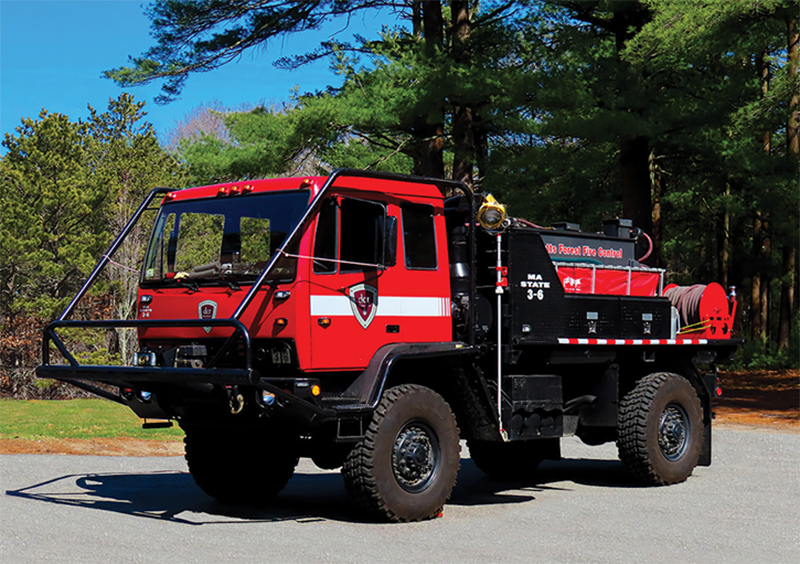
2 Forestry 3-6 is a 1998 Stewart & Stevenson LMTV with a 100-gpm high-pressure pump, 1,000-gallon tank, and 10-gallon foam cell.
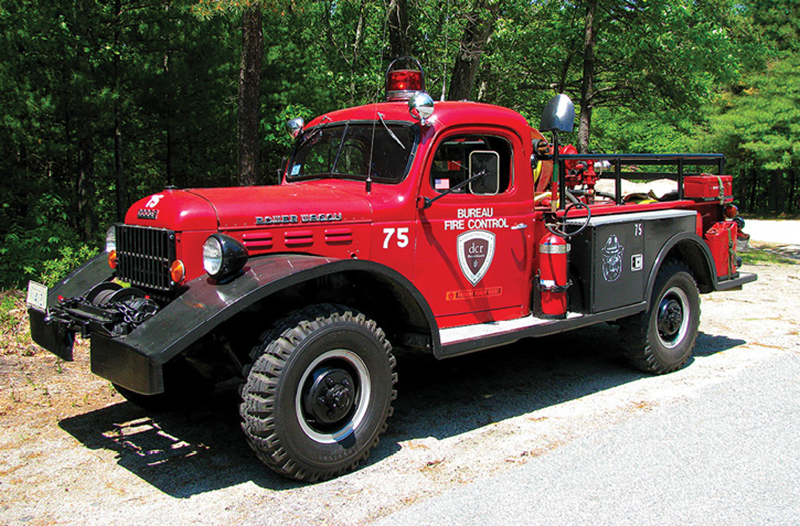
3 Patrol 7-5 is a recently retired 1964 Dodge 4×4 Power Wagon with a 110-gpm pump and 200-gallon tank. Note the “semiprotected” beacon ray.
Alan Petrillo’s article titled “Developments in Wildland Rigs and Wildland Urban Interface Pumpers” (bit.ly/3Luyx7k) gives an excellent technical overview of current offerings by various manufacturers.
Terminology used by the manufacturers in Petrillo’s article is mirrored on dozens of OEMs’ Web sites. Examples include: wildland, WUI, Type 3 urban interface pumper, wildland interface pumper, interface pumper, wildland apparatus, hybrid between a Type 1 and a traditional wildland rig, WUI pumpers, wildland engines, multipurpose wildland brush truck that also handles structures, WUI engines, mini/wildland pumper, and an interface bridging the gap between a traditional mini and a full-blown pumper. Note the word wildfire is seldom, if at all, used by the OEMs in describing their products. Smokey Bear’s slogan might be in line for another makeover.
Manufacturers are not being belittled or criticized for creating their own terminology. There are no rules or regulations for marketing and sales strategies. Kudos to any that can successfully sell fire apparatus advertised as meeting the undefined requirements of a WUI apparatus. Deserving equal astonishment are those also successfully selling apparatus without advertising what regulatory standard or standards the rigs meet.
ARE STANDARDS IMPORTANT?
There are nationwide voluntary consensus standards, such as those published by the National Fire Protection Association (NFPA), that are adopted as law by some political subdivisions. NFPA standards could also become part of legally binding contracts between local governments and independent volunteer fire departments as well as professional organizations representing career firefighters. Federal and state agencies that purchase fire apparatus may or may not require NFPA compliance. Some agencies have their own requirements and terminology, such as the aforementioned Type 1 and Type 3, which will be explained later.
If a purchaser expects a WUI purchase to be counted toward an insurance rating such as those determined by the Insurance Services Office (ISO), the purchaser should ensure, in writing from both the manufacturer and the rating organization, that the rig being specified will do so. It would be unfortunate to spend hundreds of thousands of dollars to purchase an expected NFPA-compliant rig and then not achieve a rating because of adding or deleting features to make it fit an OEM’s abstract definition of a WUI apparatus. To the best of my knowledge, the ISO does not recognize a WUI apparatus.
The same applies for compliance with a specific NFPA standard required by the purchaser’s authority having jurisdiction (AHJ). Interestingly, OEMs’ Web sites and literature seldom—if at all—indicate if their offerings meet NFPA standards. The NFPA also does not recognize WUI apparatus but does recognize wildland fire apparatus.
There are numerous federal and state grant programs, both formal and some derogatorily called pork barrel, where fire departments can apply for monies for specific applications. These programs may require compliance with criteria unbeknownst to the fire department. State and federal agencies and bureaucracies may have their own definitions of wildfires, wildland fires, and forest fires as well as specification criteria for apparatus to combat them. It would be unfortunate if a fire department failed to secure a grant because it didn’t know what a wildland fire is.
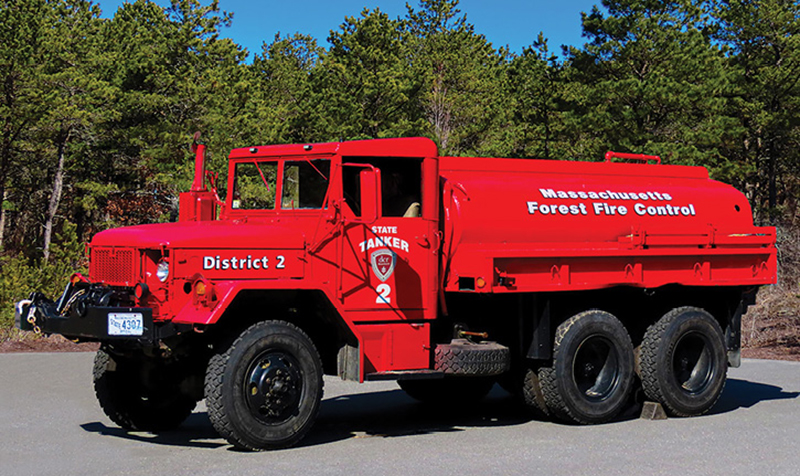
4 Tanker 2-1 is a 1985 AM General 2½-ton 6×6 with a 125-gpm pump and 1,200-gallon tank.
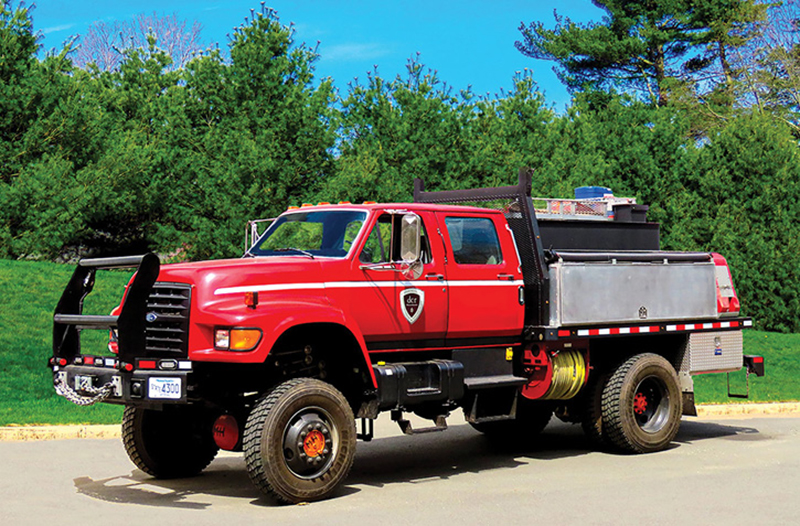
5 Forestry 10-6 is a 1998 Ford F800 four-door 4×4 “District-built” rig with a 250-gpm pump and an 850-gallon tank.
Some state and federal agencies might specify apparatus that are not required to have NFPA-compliant warning lights and sirens. Adding your own light bar and a siren to one purchased used or to a homebuilt rig does not necessarily mean you can legally call for or block the right-of-way on a public highway (photos 1- 7).
A conundrum for purchasers and manufacturers alike is defining WUI apparatus and the types of fires they are designed to combat. Manufacturers’ interpretations of vague and ambiguous terms can vary so much that the competitive bidding process is negated. I am not advocating that apparatus manufacturers must use the same terminology in their specifications and marketing strategies. They have the right to call their rigs whatever they want. Regardless of the moniker manufacturers give their rigs, their advertising ought to indicate which specific regulatory standards their apparatus will be built to. Concurrently, purchasers have an obligation to their taxpayers, the manufacturers who may bid, and the firefighters who’ll staff the apparatus to explicitly define the regulatory standards the anticipated purchase shall meet.
HISTORY
In 1876, the United States Congress made the United States Army responsible for “forest fire management.” My assumption is forest fire management included fighting forest fires. One can only guess what tools were available for a troop of mounted cavalry to use in combating forest fires. Eventually, the United States Department of the Interior assumed the responsibility of forests until 1905 when President Theodore Roosevelt transferred their care to the Department of Agriculture’s newly established United States Forest Service.
The adage “Too many cooks in the kitchen can spoil the soup” is a saying where individuals with separate agendas working toward a common goal may result in an inferior product. There is no such accusation for WUI apparatus. Knowing who has had their hands in the soup may help readers understand how and why specifications for WUI apparatus were developed.
At the state level, the first official recognition of fighting forest fires I found was in Massachusetts. From its Web site, “Since 1911, the Massachusetts Department of Conservation and Recreation’s Bureau of Forest Fire Control has been providing aid, assistance, and advice to the Commonwealth’s cities and towns through its Wildfire Mission.” It still does today. It maintains a large fleet of state-owned and seasonally staffed fire apparatus in 14 districts located throughout the state. Some were purchased rigs and others were homemade (photo 6).
On the other side of the country, California developed an extremely comprehensive statewide fire resource plan administered by Cal OES (Governor’s Office of Emergency Services). Known as the California Fire Service and Rescue Emergency Mutual Aid System, it began before World War II as the California War Powers Act. Paraphrasing from its excellent history, Cal OES Fire and Rescue History and Organization, Cal OES outlines how the program was started. Although not officially recognized as doing so, it eventually morphed into predominantly providing resources for fire disasters in “the forest and watershed areas” and in the “California wildland.” Cal OES purchases fire apparatus per its own specifications for distribution throughout the state to local fire departments on a contractual basis. Two points of interest: California was shelled by an enemy submarine early in World War II. According to the United States Air Force Museum, during the war, approximately 9,000 enemy incendiary balloons (balloon bombs) were launched against the continental United States ostensibly to start forest fires. Of the 285 confirmed incidents in the country, some of the balloons landed in California.
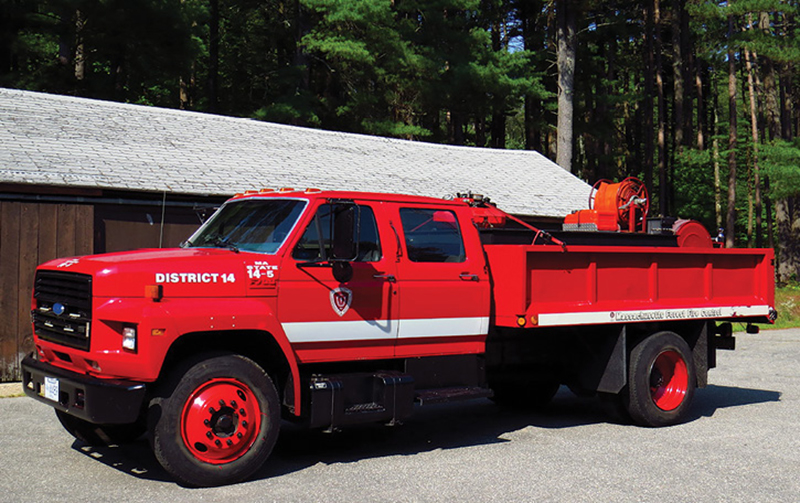
6 Tender 14-5 is a 1994 Ford F700 four-door unit with a 110-gpm pump and 650-gallon tank.
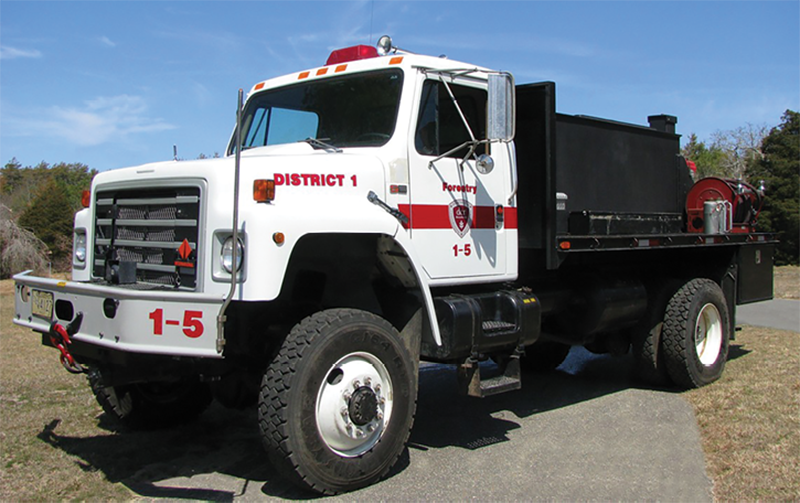
7 Forestry 1-5 is a 1989 International 4×4 with 110-gpm pump and 600-gallon tank.
Space constraints prevent listing every state that had or currently has purchased fire apparatus to combat “vegetation” fires. However, it is noteworthy that, since 1906, the New Jersey Forest Fire Service has been the agency responsible for protecting life, property, as well as the state’s natural resources from wildfire.
Addressing more on the federal level, fast forward 100 years from the horse-mounted firefighting cavalry to the NWCG. According to one of its multiple Web sites (bit.ly/3PGSOci), it was “established in 1976 to provide national leadership to enable interoperable wildland fire operations among federal, state, local, Tribal, and territorial partners.” Paraphrasing another of its Web sites, the NWCG has a 12-member appointed executive board representing each member entity that oversees 17 committees and 82 subcommittees/subgroups. More than 1,100 committee and subcommittee members represent their agencies and provide subject matter expertise to support interoperable wildland fire response across the nation. I remember when a fire department apparatus purchasing committee with more than a half-dozen people was thought to be unruly!
As of January 24, 2024, the NWCG Executive Board Members represented the Fish and Wildlife Service; United States Fire Administration; Bureau of Indian Affairs; Bureau of Land Management; Department of Defense; Forest Service-Wildland Fire Management Research, Development, and Application; International Association of Fire Chiefs; Intertribal Timber Council; National Park Service; Forest Service Fire & Aviation Management; and National Association of State Foresters. The NWCG Web site says it continues to provide leadership for a seamless response to wildland fire across the nation. Not to confuse but to give credit where due, the NWCG was formerly known as the National Interagency Fire Center and before that as the Boise Interagency Fire Center.
The NWCG has published a one-page chart showing the minimum performance requirements of seven fire apparatus: two designated as “structure” and five designated as “wildland brush trucks.”
THE BIG QUESTION
Do any of the seven NWCG apparatus types, especially those designated “structure,” have to be compliant with any NFPA standard?
A follow-up article will address that question and the collaboration—if any—between the NWCG and the NFPA’s soon-to-expire existing and future fire apparatus standards. Apparatus specifications will be addressed. Insight will be provided by a fire apparatus manufacturer that has extensive experience building wildland apparatus for various federal, state, and local entities throughout the western states.
PHOTOGRAPH NOTES
Mike Boynton, owner of https://massfiretrucks.com/, provided the photos in this article. His Web site includes photographs of almost every fire truck in Massachusetts and Rhode Island along with descriptions and station locations at their respective departments.
Photos 2 through 7 are apparatus from the Massachusetts Forest Fire Control. Although they have “official” Massachusetts license plate tags, it is unknown if they are intended for use “on the public highway” as emergency vehicles. The inconsistency in warning devices indicates that not all, if any, are. They are housed in 14 districts in the state and are seasonally staffed.
BILL ADAMS is a member of the Fire Apparatus & Emergency Equipment Editorial Advisory Board, a former fire apparatus salesman, and a past chief of the East Rochester (NY) Fire Department. He has 50 years of experience in the volunteer fire service.

